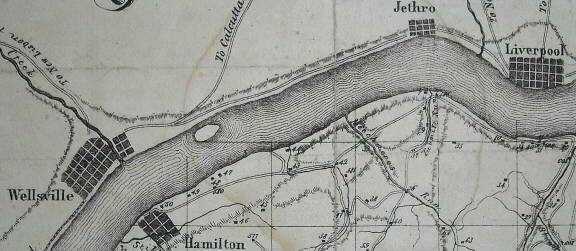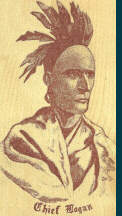|
The history presented here was written by Glenn Waight in the late 1950s. It ran in the East Liverpool Review in 1957 with excerpts being reprinted in 1976. Portions
of it have appeared in different reference books, but they fail to give proper credit to the author.
Since this piece is going on sixty years old, some of the information is either out of date or incomplete. I've added explanatory footnotes rather than revise the original writing. Images shown did not appear in the original article.
The town site, long and woodland farm area which had over looked the Ohio River from the time of the silent canoe through the era of the smoke belching steamboat, first began to stir after the turn of the century when its potential as an industrial location was realized.
Newell has always been a pottery town, and its history is closely linked with names like Laughlin, Wells, and Knowles and factors such as corporation taxes, tunnel kilns and tariff levels.
A glance across the years to 1907 brings to mind a nostalgic memory of the Rush Grocery Store at 5th and Washington, the Gates Butcher Shop in the Rauh Building, the first summer of social functions at the new Kenilworth Country Club and the steady construction of new homes.
School was being held in the Aaron Building, where the Presbyterian congregation was worshiping.
And humming along the river was the giant Homer Laughlin China co. Plant No. 4 - the world's largest and most modern pottery and the nucleus of the mushrooming pottery move from East Liverpool.
 The flatland along the river, first the unchallenged hunting are of the Indians and later under the flags of the French and British, began to echo the settler's ax following the establishment of Col. Ebeneezer Zane's outpost at Wheeling in 1769.
The depredations of the Indian Wars slowed the western expansion from the Alleghenies somewhat, but the Scotch, Irish, German and English moved out of Pennsylvania and Maryland into the lush valley.
William Hamilton settled along the river in 1795 and laid out Hamilton Town, a tiny village which existed during the 1800's south of the site of Newell. William Chapman had settled in 1785 near New Cumberland, the same year Jacob Nessly settled on Tomlinson Run, owning land a mile back from the river and up to opposite Wellsville.
When Thomas Fawcett settled at East Liverpool in 1796, his neighbors on the Virginia shore included the farm of Christy Brenneman opposite Yellow Creek, bottomland of John Hamilton Sr. opposite Wellsville and his son, Linn, at the lower end, and Harvey Heath who was east of Hamilton. The flatland along the river, first the unchallenged hunting are of the Indians and later under the flags of the French and British, began to echo the settler's ax following the establishment of Col. Ebeneezer Zane's outpost at Wheeling in 1769.
The depredations of the Indian Wars slowed the western expansion from the Alleghenies somewhat, but the Scotch, Irish, German and English moved out of Pennsylvania and Maryland into the lush valley.
William Hamilton settled along the river in 1795 and laid out Hamilton Town, a tiny village which existed during the 1800's south of the site of Newell. William Chapman had settled in 1785 near New Cumberland, the same year Jacob Nessly settled on Tomlinson Run, owning land a mile back from the river and up to opposite Wellsville.
When Thomas Fawcett settled at East Liverpool in 1796, his neighbors on the Virginia shore included the farm of Christy Brenneman opposite Yellow Creek, bottomland of John Hamilton Sr. opposite Wellsville and his son, Linn, at the lower end, and Harvey Heath who was east of Hamilton.
 Next was the land of Fred Greathouse and beside him was the John Gardner farm on which Chester was later founded. Greathouse sold to Murray and the tract later became the Wells farm.
A blockhouse was built at the Nessly site for portection of the settlers from Indians and another was constructed farther upstream, probably at the Greathouse tract close to the present Newell site.
Jonathan Muchmore settled close to Greathouse, and it is apparently after him the creek through the town was named. Tradition has it that a Sam Muchmore and Daniel Greathouse were involved in the murder across from Yellow Creek of the mother, brother, and sister of the Mingo Chief Logan, which resulted in a frontier war of savage vengeance in 1774.
Next was the land of Fred Greathouse and beside him was the John Gardner farm on which Chester was later founded. Greathouse sold to Murray and the tract later became the Wells farm.
A blockhouse was built at the Nessly site for portection of the settlers from Indians and another was constructed farther upstream, probably at the Greathouse tract close to the present Newell site.
Jonathan Muchmore settled close to Greathouse, and it is apparently after him the creek through the town was named. Tradition has it that a Sam Muchmore and Daniel Greathouse were involved in the murder across from Yellow Creek of the mother, brother, and sister of the Mingo Chief Logan, which resulted in a frontier war of savage vengeance in 1774.
The Indian wars subsided, the conflict with Great Britain resulted in independence and the forests were pushed back. Farms were developed, fruit orchards planted and construction of grist mills and distilleries followed, along with crude school houses.
In 1800 Hugh Pugh and his family, originally from New Jersey, moved from Burgettstown, Pa., to a 400-acre tract in the heart of the upper part of the county, launching the community of Pughtown or Fairview or New Manchester. This village, along with Georgetown, Pa., was one of the larger communities in the district during the early part of the 19th century and served as the Hancock county seat for many years.
One of the early settlers at Pughtown was John Newell, a tanner, whose son, Hugh Newell, became the owner of the site where now more than 2,000 people reside.[1] Hugh was born September 16, 1827 at Pughtown and in 1859 was married to Alizan marks, a daughter of Sam marks who resided at Rock Springs, a track along the river northeast of the John Gardner farm which became later a good picnic spot and then the site of the present amusement park.[2]
Hugh Newell, a farmer, was widely known throughout the area. He was a stanch Republican. In 1886 he moved to an old stone house in Chester. he died June 15, 1904, while attending the funeral of an old friend in East Liverpool.
Among the earlier settlers in Grant District were Samuel Baxter, 1798; William Hutson near Hamilton Town, 1803; William Mercer, 1823; James Allison on the road between Pughtown and the East Liverpool crossing, 1800, and William Rodgers, 1975, killed and mutilated by Indians in 1796 while out hunting wayward cattle.
The chief occupation of the district was farming, although early in the 19th century the clay and coal deposits of the valley began receiving notice. About 1830 Thomas Freeman began to dig clay at the mouth of Holbert's Run, south of New Cumberland, for shipment to Pittsburgh, where bricks were made. James S. Porter, realizing the potential value of the county shore where clay, wood, and coal sources were close together, began making bricks at the site. Brick manufacture spread, and soon the kell boats were hauling loads up to Pittsburgh iron and steel mills and flatboats carried the bricks to Wheeling.
Hancock county was formed from the upper end of Brooke county in January 1848, and a close election established the county seat at New Manchester (Fairview) instead of New Cumberland. A brick courthouse was built in 1850. Six school districts were formed in 1848, with Squire John Gardner as supervisor of the district in the north.
1 In 2000, there were 1,600 residents.
2 Rock Springs Amusement Park closed in 1970.
|